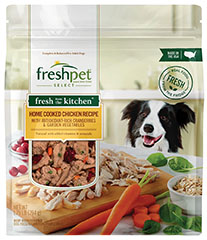This article was published in the March 2023 issue of Pet Food Processing. Read it and other articles from this issue in our March digital edition.
In recent years, fresh, preservative-free products have become increasingly popular among pet owners. However, these products come with a unique challenge for pet food manufacturers and distributors — ensuring the food is kept cold during transport and storage. Without an effective cold chain management system, fresh pet foods can quickly spoil, leading to waste and customer dissatisfaction.
To maintain freshness and safety, pet food manufacturers must employ a rigorous cold chain management system that ensures proper temperature control from production to delivery. This involves a combination of temperature-controlled storage and transportation, as well as monitoring temperatures at various points along the supply chain. While this process can be costly, it is essential to protect food safety and quality while maintaining customer satisfaction.
Maintaining freshness
Secaucus, NJ-based Freshpet is one pet food manufacturer that has implemented a comprehensive cold chain system that includes several measures to ensure product freshness. The first step is storing product locally near its manufacturing facility, allowing for quick and efficient distribution. Strict protocols are then followed to ensure that products are stored, transported and handled at the right temperatures.

Freshpet’s fresh pet food must be kept cold from the time it leaves the processing plant to when it is placed in the retailer’s refrigerated cases, which leads to transportation and distribution challenges for the processor.
|“We store our product locally to our manufacturing and then quickly distribute to our customers through multiple nodes of warehousing and modes of distribution,” explained Dirk Martin, vice president of logistics and customer service, Freshpet. “Focus is on the timely transfer to our customer distribution channels to maximize the freshness and shelf life of our products. We have set rigid standards with all segments of our cold chain through documented handling processes of our products, and we do temperature checks and utilize temperature recorders throughout the process to log statuses.”
Vital Essentials, a premium pet food brand distributed by Green Bay, Wis.-based parent company Carnivore Meat Company that specializes in frozen and freeze-dried raw pet food, snacks and treats, also takes temperature control seriously. Key to its commitment to freshness is the use of refrigerated trailers and storage facilities specifically designed for cold food storage, as well as continuous temperature monitoring systems.
“Focus is on the timely transfer to our customer distribution channels to maximize the freshness and shelf life of our products,” said Dirk Martin, Freshpet.
“Vital Essentials is very intentional when it comes to controlling the cold chain and maintaining quality,” said Brian Lakari, vice president of operations, Carnivore Meat. “Our cold chain distribution process includes four main points of control: vendor processing, transportation, storage and our internal manufacturing. Cold food products are harvested and processed in USDA facilities having temperature controls capable of maintaining the required product temperature throughout the facility. The care we take shows in the finished products we provide to pet parents all over the world.”
Cold chain challenges
When it comes to managing the cold chain, pet food companies must contend with a number of challenges. Some of the most common issues include limited carrier capacity, lack of cold warehouse space, and the logistical challenges posed by rapid growth. However, with the right strategies in place, these obstacles can be overcome.
“Like most companies over the last couple of years, we have dealt with the challenges of tight carrier capacity and limited cold warehouse space. We built long-term relationships with our supplier partners in both areas to ensure stable returns for them and safeguard sufficient supply chain capacity to fulfill our customer expectations,” Martin said.

Freshpet offers a full range of fresh pet food items that all must be kept refrigerated before and after purchase.
| Source: FreshpetLakari added, “Vital Essentials continues to grow at a record pace, and this can introduce new challenges, such as the availability of frozen cold storage warehousing. We have been successful in addressing this challenge for years, by building our own freezer warehousing. We currently own three sizable frozen warehouses. Two are attached to our manufacturing facilities and another is stand-alone. We are currently constructing a fourth frozen warehouse, which will be located inside our brand new 235,000-square-foot state-of-the-art manufacturing facility in Green Bay. We believe that owning and managing our own facilities allows us to control all aspects of not only the cold supply chain but also the entirety of the manufacturing processes.”
Incremental improvements
Pet food processors are also taking steps to further improve the efficiency and safety of their cold chains. Whether it be through technology upgrades or small process changes, these improvements help ensure that pet owners receive the freshest, most nutritious products available.
“We continuously monitor cold chain technology in an effort to identify opportunities and invest in technologies that enhance our ability to ensure food safety and effectively provide value for our clients,” Lakari said. “In recent years, we made a significant investment in ERP [enterprise resource planning] and warehouse management systems, along with hi-tech RFID [radio frequency identification] systems, which enhances our ability to safely and appropriately manage temperature-sensitive food products. We have recently invested in innovative packaging solutions that have provided greater temperature control.
 The increase in the number of fresh and frozen pet food brands adds to the cold chain distribution challenges pet food processors face. | Source: ©KOKLIANG1981 – STOCK.ADOBE.COM
The increase in the number of fresh and frozen pet food brands adds to the cold chain distribution challenges pet food processors face. | Source: ©KOKLIANG1981 – STOCK.ADOBE.COM
“Going forward, we will be implementing robotic technology as part of our brand-new manufacturing facility, due to be completed in Q4 of 2023. This technology will provide more efficient transfer and storage of cold food products,” he added.
Freshpet has also taken proactive steps to improve operational efficiency. These efforts include implementing new solutions to benchmark its freight and upgrading its transportation management systems. The resulting changes impact both the company’s internal processes and its customer service.
“We have recently implemented a few new solutions to assist in benchmarking our freight and partnering with our 3PLs [third-party logistics] for a dynamic pricing solution to control freight costs in line with market changes,” Martin said. “We are also building out transportation management solutions to improve our load control, tracking and communication of shipment statuses to our customers.”
Fresh partnerships
Partnering with the right third-party logistics providers can make all the difference for pet food processors that need to maintain the integrity of their cold chain. By leveraging their expertise, companies like Vital Essentials and Freshpet are able to ensure that their products are delivered safely and on time.
“We are partnering with the largest cold chain warehouser and a couple of the top logistics 3PLs for the daily storage and distribution of our products,” Martin said. “Our warehouse partnership allows us a footprint close to our manufacturing, as well as key distribution locations close to our markets and transportation lanes. It allows us to shorten our lead time to customers and increase our inventory turns. The partnership with our 3PLs also has allowed us speed to market with broader access to carrier options.”

Carnivore Meat Company broke ground on its new 235,000-square-foot headquarters and manufacturing facility last August. The new facility will produce its flagship freeze-dried pet food brand, Vital Essentials.
| Source: Schuh Construction Inc.Lakari also stressed the importance of such partnerships, noting that Vital Essential’s partnership with D&G Transportation has allowed them to expand the company’s supply chain capabilities.
When selecting a third-party logistics provider, it is essential that pet food companies thoroughly vet the partner’s capabilities and services. Ensuring food safety is critical, so providers must understand cold chain challenges at hand and have the necessary capabilities to meet safety standards.
“Cold food products are transported via refrigerated trailers equipped with continuous automated temperature monitoring systems and they are stored in warehousing facilities designed specifically for cold food product storage, also equipped with continuous temperature monitoring systems,” Lakari explained. “This is imperative, not only for the purpose of maintaining meat quality, but to comply with the strict standards of GFSI Certification, under FSSC 22000. GFSI is voluntary food quality and safety accreditation that Vital Essentials has very successfully undertaken since 2015. Carnivore Meat has implemented preventive controls to ensure required product temperatures are maintained throughout the cold chain. Our cold chain service providers are evaluated and continuously monitored to ensure effective controls are in place, while internal preventive controls have been established to verify required temperatures are maintained while cold food products are in our control.”
Read more about pet food and treat processing on our Operations page.



